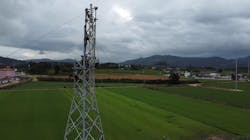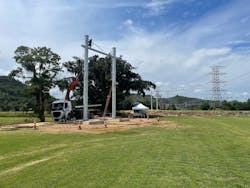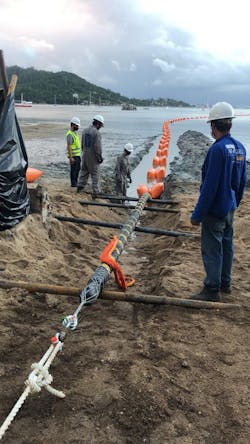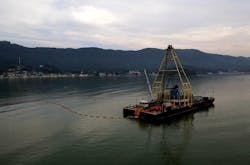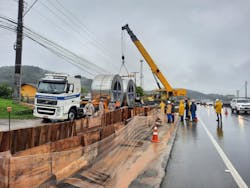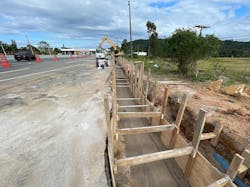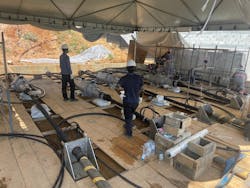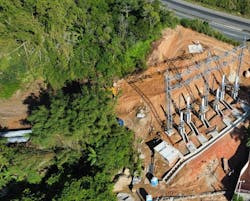Brazil’s Mainland-to-Island Interconnection
ISA CTEEP — the largest private transmission utility in Brazil, servicing 17 states — won an auction hosted by the Brazilian Electrical Energy Regulatory Agency to construct, commission, maintain and operate a transmission line that would provide a guaranteed energy supply for 25 years to the city of Florianópolis, the state capital of Santa Catarina. The 230-kV extension of the transmission system required an overhead line section of 10 km (6.2 miles) in length, a 13-km (8.1-mile) subsea cable section and an underground cable section of 4 km (2.5 miles) in length. Circuit interconnections from the existing 230-kV Biguaçu substation on the mainland to the 230-kV Ratones substation had to be constructed on the island of Santa Catarina.
Several solutions were developed to overcome numerous difficulties encountered along the planned route of the 230-kV circuit, requiring the need for new and unusual technologies from the design stage and feasibility studies to the commissioning and energization phases. One of the key challenges and difficulties encountered was environmental restrictions.
For example, the underground cable section was near an extensive flora and fauna permanent preservation area. The channel the submarine cable had to cross is crowded with oyster and shellfish farms. The Santo Antônio de Lisboa district, where the underground cable section would begin, is listed in the historical heritage of Florianópolis, with ancient streets and buildings, and is an important touristic attraction for the municipality. ISA CTEEP required innovative solutions to minimize its expenditures while overcoming environmental challenges like these along all sections of the route.
Overhead Line Section
The overhead line section consists of two single-circuit 230-kV transmission lines erected on structures with sufficient clearances between circuits to avoid conductor clashing and disconnection or damage of both circuits in the event of structure failure, as this region is subject to strong winds.This solution provides the reliable supply of energy required in accordance with the auction edict.
Several studies of the routes were undertaken using satellite images, available maps and field visits to determine the shortest routes in terms of the engineering environment and real estate requirements. The overhead line has two distinct sections with significant differences in the design of the overhead line supporting structures. There is a section in a rural area some 9 km (5.6 miles) in length and an urban section approximately 2 km (1.2 miles) long.
The structures used in the rural stretch are self-supporting lattice towers with a right-of-way (ROW) 40 m (131.2 ft) wide and an average span of 450 m (1476.4 ft) between structures. Steel poles were specified for use in the urban section with a ROW 15 m (49.2 ft) wide and spans of 165 m (541.3 ft).
The transmission line cable is the AAAC 1120 (all aluminum alloy conductor), having a 474.8 sq. mm (937 MCM) cross-section, with 61 wires, and 107 kN (24,054-lb-ft) breaking load.
Polymeric insulators dimensioned according to the minimum basic insulation level (BIL) were used for the suspension, jumper and tension insulator strings to guarantee adequate performance of the line insulation against lightning strikes. The mechanical dimensioning of the insulators respected all conditions:
maximum compression, traction and flexion.
The loads acting on the transmission line structures were calculated from the characteristics of the overhead line conductors used and design wind pressures. The series of structures for the rural stretch of the transmission line consisted of five types of towers. The series of poles used in the urban stretch consisted of three types of structures. All structures were heavily galvanized because of the region’s salinity, being close to the sea.
To define the foundations, standard penetration tests (SPTs) were undertaken. In places where the soil proved to be impenetrable to the SPT in levels below 3 m (9.8 ft), rock drilling was carried out to characterize the rocky top.
In the flat regions with altitudes below 15 m (49.2 ft) above sea level, the soil was predominantly weak, with extensive layers of organic clay. In regions with higher altitude and rugged relief, the rocky top was found in the surface layers.
For the towers, located mainly in hilly areas, conventional cast-in-situ concrete piles and pad foundations were adopted. For the tubular steel poles, used mainly in areas at lower altitude and, consequently, in areas with weaker soil — because of the high resulting loads on the foundation — it was necessary to adopt solutions using steel piles or root stakes, reaching blocks with 12 piles up to 28 m (91.9 ft) deep.
Submarine Cable Section
The 230-kV submarine cable section comprised six single-core cables, buried 1 m (3.3 ft) into the seabed. For security reasons, these cables were installed with a 25-m (82-ft) spacing between phases.
Several surveys were conducted at the installation site of the submarine cable section, including soil thermal resistivity, bathymetry, high-resolution seismic, lateral scanning sonography and sedimentology of samples from the soil removed on the seabed.
The single-core insulated cables selected for this project were 1200-sq mm (2368-MCM) aluminum conductors to reduce the costs. The cable is dimensioned based on the IEC 60287 and IEC 60853 standards.
The basic formation of the cable is stranded aluminum conductor with an extruded semiconducting screen, cross-linked-polyethylene (XLPE) insulation, extruded semiconducting screen, water-blocking layer, lead-alloy sheath, anticorrosion high-density polyethylene (HDPE) sheath, polypropylene yarn filler, armor bedding, copper-wires armor and polypropylene yarn with bitumen.
There are no joints in the submarine cables, as each phase was manufactured in a unique length to avoid weak points that could occur in the accessories of insulated cables.
A critical problem encountered in the submarine cable section was the installation of the 230-kV cables in shallow water. It was necessary to plan out detailed logistics for receiving the cable in a harbor some 70 km (43.5 miles) from the installation site. This distance required the use of a shallow draft barge adapted for transporting and installing the cables.
It is important to note that although some companies in Brazil had experience with maritime works in the oil and gas exploration sector in the high seas, there were no companies on the South American continent with experience in laying submarine cables in shallow waters. Therefore, it was necessary to develop local companies to execute these services.
Underground Cable Section
The underground cable section of the 230-kV transmission circuit connects the submarine-underground transition zone in Santo Antônio de Lisboa to the Ratones substation. It comprises two circuits installed in a single trench, in a vertical flat formation, with an approximate length of 4 km (2.5 miles).
Santo Antônio is a tourist region with several points of historical interest and dense residential and commercial zones. Therefore, the cable route was developed to reduce the impact to the region, especially to avoid creating socioenvironmental disorders. The route of the underground cable circuit avoided crossing the historic center of the village, following the neighboring streets and avenues and then along the shoulder of the SC-401 state highway.
Field surveys were carried out — including topography, interference mapping, thermal resistivity, electrical resistivity and geotechnical surveys — before defining and confirming the exact cable route and specifying the 230-kV underground cable installation of 1600-sq mm (3158-MCM) aluminum conductor, XLPE insulation, a metallic sheath with copper wires and HDPE outer sheath.
Cable Transitions
The transitions — from the overhead line to the submarine cable sections and the submarine cable to the underground cable sections — were completed as follows:
The overhead line to submarine cable transition was completed in the Biguaçu municipality, where there were space restrictions as a result of existing houses in the beach area. The solution adopted for this transition was a gantry structure to receive the overhead cables and terminations installed over steel-lattice structures, in an area of approximately 27 m (88.6 ft) by 63 m (206.7 ft). The other major difficulty overcome was the need to construct a high tower to cross a main highway close to the transition area.
The submarine cable to underground cable transition took place on the island of Santa Catarina. It was achieved by simply jointing the submarine and underground cables using special joints to accommodate the two different types of cables. These transition joints were installed in a concrete box and directly buried. The box was filled with a special backfill with low thermal resistivity and thermally stable characteristics to ensure adequate thermal performance of the system (cable and joints). To protect the joints and cable, the concrete box was covered by pre-molded concrete slabs.
Uncommon Solutions
Innovative and uncommon solutions had to be developed and used in this project to overcome the countless challenges that arose.
The main challenge was to reduce the costs of this project at the design stage to be competitive in bidding. Unconventional solutions were chosen specifically for this reason. The main one was the use of aluminum conductors instead of copper in the submarine cable, which was unforeseen in the bidding documents. Although aluminum has been used as the conductor core in high-voltage underground cables in the last 10 years in Brazil, it was not common to use aluminum conductors in submarine cables.
Many developed countries use copper conductors in submarine cables, and there was a strong reaction to employing aluminum. Nevertheless, ISA CTEEP opted to use aluminum following research and discussion with European utilities. This solution brought a significant cost reduction to the project.
Another important achievement was the development of local companies to lay and bury the submarine cables in the seabed. As previously stated, there were no such companies in South America with this type of experience in shallow waters. The cost of using international companies with this experience was very high; therefore, the use of local companies represented an important economic benefit.
Environmental restrictions in the region where the submarine cables were installed presented major difficulties. There were marine farms that breed oysters and shellfish of great commercial importance for the region. Furthermore, very close to this location, on one of the banks of the marine channel, is an extensive area of permanent environmental preservation that cannot be subject to any form of intervention. The solutions used to lay and bury the cables caused minimal movement of the marine soil during the laying and burying of the cable, and they avoided any approach to the environmental preservation area.
Installation of the underground cables did not present too many problems during the execution. Despite the limitations of routes in the village of Santo Antônio de Lisboa because it is a historical site, it was possible to find a good alternative. Almost all the underground cable route ran along the shoulder of
the highway that joins Santo Antônio de Lisboa to Ratones, the location of the new substation.
During the execution of the civil works for the construction of the duct bank, using the open-air trench method, the main difficulty encountered was the large volume of traffic on the highway during the summer tourist season. This heavy traffic required special measures to preserve the safety of workers, tourists and citizens.
The combination of management focused on environmental, social and governance (ESG) practices, a strong engineering team, solid suppliers and consultants resulted in innovative and uncommon solutions being used to construct the new rural-to-urban 230-kV transmission circuit line. This mutual cooperation started before the auction took place and continued through the project commissioning. This resulted in a successful project that achieved all the goals of the business plan, which ultimately won the auction with a discount of 67% off the base price of the authorized tariffs.
This project included the largest installation of submarine cable in Brazil forming a section of the 230 kV interconnection now in operation between the island of Santa Catarina in the southern region of the country to mainland Brazil.
Caetano Cezario Neto ([email protected]) is an electrical engineer at ISA CTEEP. Cezario has been working with high-voltage and extra-high-voltage
transmission lines and substations for 34 years in engineering, design and construction. He holds a degree in electrical engineering from the University of Barretos, a MBA degree in engineering from the University of São Paulo, a MBA degree in finance from Ibmec and a MBA degree in management from Dom Cabral in Brazil.
Rogério Lavandoscki ([email protected]) is a mechanical engineer at ISA CTEEP. Lavandoscki has been working with high-voltage and extra-high-voltage transmission lines for 27 years in engineering, design, construction and maintenance. He holds a degree in mechanical engineering from Methodist University of Piracicaba, a master’s degree in engineering and materials science from Federal University of São Carlos and a MBA degree from Getulio Vargas Foundation in Brazil.
Vitor Ortega de Abreu Neves ([email protected]) is a project coordinator at ISA CTEEP. He has served in the overhead transmission engineering area and project management for more than seven years. He holds a degree in mechanical engineering from Centro Universitário da FEI and a post-graduate degree in the upstream oil and gas industry of Catholic University of Petropolis and business project from Insper.
Jody Fujihara ([email protected]) is an electrical engineer at ISA CTEEP. Fujihara has been working with high-voltage and extra-high-voltage transmission lines for 10 years in engineering, design and construction. He holds a degree in electrical engineering from São Paulo State University and a MBA degree from Getulio Vargas Foundation in Brazil.
Renato Mansur ([email protected]) is an electrical engineer at ISA CTEEP. Mansur has been working with extra-high-voltage transmission lines for 13 years in engineering, design and construction. He holds a degree in electrical engineering from Pontifical Catholic University and a MBA degree from the University of São Paulo in Brazil.
Julio Cesar Ramos Lopes ([email protected]) is a director of Inovatec Consulting & Engineering and a member of IEEE. Lopes held management positions for more than 25 years at AES Eletropaulo in engineering, system planning, design and construction of high-voltage and extra-high-voltage substations and transmission lines. He served as Chairman of the SC B1 Insulated Cables of the Brazilian National Committee of CIGRE from 2008 to 2014. He holds a degree in electrical engineering from the Polytechnic School and an international executive MBA degree from the Fundação Instituto de Administração of the University of São Paulo, Brazil.
About the Author
Rogério Lavandoscki
Rogério Lavandoscki ([email protected]) is a mechanical engineer at ISA CTEEP. Lavandoscki has been working with high-voltage and extra-high-voltage transmission lines for 27 years in engineering, design, construction and maintenance. He holds a degree in mechanical engineering from Methodist University of Piracicaba, a master’s degree in engineering and materials science from Federal University of São Carlos and a MBA degree from Getulio Vargas Foundation in Brazil.
Vitor Ortega de Abreu Neves
Rogério Lavandoscki ([email protected]) is a mechanical engineer at ISA CTEEP. Lavandoscki has been working with high-voltage and extra-high-voltage transmission lines for 27 years in engineering, design, construction and maintenance. He holds a degree in mechanical engineering from Methodist University of Piracicaba, a master’s degree in engineering and materials science from Federal University of São Carlos and a MBA degree from Getulio Vargas Foundation in Brazil.
Jody Fujihara
Jody Fujihara ([email protected]) is an electrical engineer at ISA CTEEP. Fujihara has been working with high-voltage and extra-high-voltage transmission lines for 10 years in engineering, design and construction. He holds a degree in electrical engineering from São Paulo State University and a MBA degree from Getulio Vargas Foundation in Brazil.
Renato Mansur
Renato Mansur ([email protected]) is an electrical engineer at ISA CTEEP. Mansur has been working with extra-high-voltage transmission lines for 13 years in engineering, design and construction. He holds a degree in electrical engineering from Pontifical Catholic University and a MBA degree from the University of São Paulo in Brazil.
Julio Cesar Ramos Lopes
Julio Cesar Ramos Lopes ([email protected]) is a director of Inovatec Consulting & Engineering and a member of IEEE. Lopes held management positions for more than 25 years at AES Eletropaulo in engineering, system planning, design and construction of high-voltage and extra-high-voltage substations and transmission lines. He served as Chairman of the SC B1 Insulated Cables of the Brazilian National Committee of CIGRE from 2008 to 2014. He holds a degree in electrical engineering from the Polytechnic School and an international executive MBA degree from the Fundação Instituto de Administração of the University of São Paulo, Brazil.
